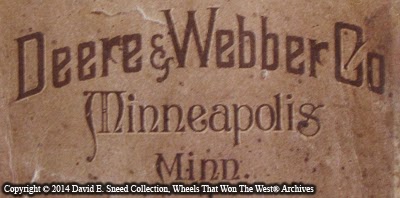Any study of early wooden wagons and theassociated industry will quickly show that the subject is full of twists,turns, tragedies, and confusing similarities. When reviewing a brand’s origins, things can get especially tricky if toomuch attention is given to the name alone. As I’ve shared before, jumping to conclusions by focusing on just onevehicle trait can quickly turn problematic.
Case in point; some may know that therewere multiple brands using the name ‘Whitewater.’ Others may not be aware that there was morethan one Columbus brand. Mitchell wagonsmay have been the “Monarch of the Road,” but ‘Monarch’ was also a label ownedby another well-known firm. These same-namechallenges can also be applied to other prominent brands such as Bain, FishBros., Brown, Smith, and more.
With this said, it’s not surprising toknow that the firm of Deere & Webber has sometimes been mistook as arelative of the Weber (one ‘b’ versus two) Wagon Company from Chicago. Even the legendary Weber & Damme of St.Louis as well as some local retail outlets have been confused with other brandscarrying the Weber name. For the record,those mentioned above are separate entities with each being a full-fledgedcompetitor of the other.
 |
| As with the John Deere name itself, the Deere & Webber firm was a trusted and exceptionally competitive brand. |
The Deere and Webber brand is especiallyinteresting as its primary role was that of a branch house or wholesale distributionoutlet in Minneapolis, Minnesota. JohnDeere had a number of these outlets including Deere & Mansur as well as Deere,Wells and Co. and others. While JohnDeere did have part ownership in these firms, they were run with some latitudefrom company headquarters in Moline, Illinois. For instance, while the sales staff at Deere and Webber were encouragedto sell John Deere products, they also sold non-Deere brands including theirown house brands. Additionally, theywere known to engage dealers that sold competing brands to Deere. While this was not the preferred direction,it did happen enough that sales representatives were repeatedly reminded of theimportance of establishing ‘full line’ John Deere dealers. In time, Deere bought each of thedistribution houses outright.
Anyone believing these early agricultureand wagon companies were unsophisticated and casual in their approach to theselling process has simply not studied enough period business correspondence. The most prominent of brands worked hard to dog,defend, and dominate every trade area possible. Broader product lines designed to meet the price points of competitorshelped many traveling agents accomplish the quotas and directives they weregiven.
 |
| Early company bulletins helped keep marketing directions and messages consistent among the company’s network of traveling sales representatives. |
In the case of Deere and Webber, 1910was a significant year for the company. Thehome office in Illinois had just purchased the legendary Moline and Fort SmithWagon companies and was in the process of developing the first ‘John Deere’ brandedwagons. Even though Deere & Webberhad beaten the main office to the punch by putting their own label on wagonsseveral years earlier, the day was coming when the name ‘John Deere’ wouldstand alone as the best of the firm’s wagon offerings. It was all part of an effort to build on thetremendous equity of the Deere name.
Today, the John Deere legacy remains apowerful force in agriculture but also benefits significantly from its growthin the construction, turf, and forestry divisions.
